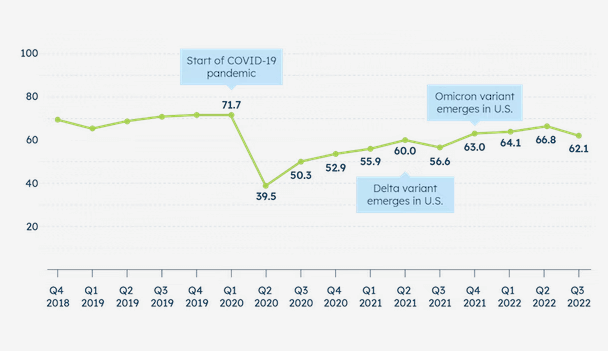THESE FIVE FACTS SHOW HOW BADLY INFLATION IS HURTING SMALL BUSINESS
This quarter, the MetLife and U.S. Chamber Small Business Index found that small businesses’ concern about inflation has reached the highest level since Q3 of last year. Here are five data points from this quarter’s report that show how inflation is hurting small business owners.
1. Inflation is the top challenge facing the small business community
Half (50%) of small businesses now say inflation is the top challenge facing the small business community. This marks the fifth consecutive quarter of increasing concern over inflation and represents a dramatic 31-point increase since this time last year (when only 19% said inflation was a top challenge).

Inflation is the top concern for small businesses regardless of their location, number of employees, or sector.
2. Most believe inflation will get worse
According to the report, most small businesses anticipate inflation will get worse. Seven in ten (71%) believe the worst is still to come with regards to inflation.Karen Olson Beenken, president and CEO of Blue Rock Companies, in Sidney, Montana, says she finds inflation everywhere she turns.
“Payroll is up because we have to pay more to retain and attract employees,” Beenken says. “The cost of fuel is up. The cost of freight is up significantly—and it’s gotten more and more difficult for us to get freight companies to come to our rural markets as frequently as they used to. Our health insurance was up this year. Those are all big cost inputs, and they are all up significantly. These are very challenging times for our business.”
3. Higher costs for goods/supplies hurting the most
The cost of goods and fuel/utility bills are where small businesses most often report feeling inflation. Among small business owners that say rising prices have had a significant impact on their business (83% of respondents), most cite the cost of goods and supplies (65%) and utilities or fuel (50%) as where they have seen the most impact. 
4. Small businesses forced to raise their prices
To keep up with inflation, many small businesses report having to raise the prices they charge customers.
“Our suppliers have passed on expenses to us, and we held on as long as we could before passing them along to our clients,” says Julianne Weiner, COO of Sonic Promos in Gaithersburg, Maryland. “Logistics [shipping and fulfillment] seem to be absorbing the worst. Though with gas prices back in the more normal range, maybe that will decrease a bit, too.”
To cope with inflation, 7 in 10 small businesses report raising prices in response to inflationary pressures, followed by those who say they have taken out a loan (40%), reduced staff (37%), or reduced the quality of their products or services (31%).
Tom Richter, principal owner of JAN-PRO of Utah based in Midvale, Utah says he’s also had to raise prices.
“Inflation has impacted our business in many ways,” Richter says. “Gas increases have required us to increase prices across the board to customers. Raw material increases have impacted chemicals and equipment used in our business. Our franchise owners have had to increase their wages to their employees doing the daily work.”
5. Most say combatting inflation should be top policy priority
When asked to choose, more small businesses said fighting inflation should be the priority over avoiding another economic downturn.
Over half (59%) of small businesses believe the priority right now should be reducing inflation and 41% would prioritize avoiding an economic downturn.
However, interest rate hikes aren’t a negligible concern. Forty percent of small businesses say they are very concerned about the impact of interest rates rising on their business (up 11 percentage points from Q1 2022).
The big picture
Amid concern around inflation, the Small Business Index score dropped this quarter to 62.1, down from 66.8 last quarter. This is the largest drop in the Index since the start of the pandemic and the drop comes from small businesses saying they are now less confident in both the national economy and their current cash flow.

The Q3 2022 survey was conducted between July 21 - August 8, 2022. For more findings from this quarter,and to explore and browse years of small business data, see our full SBI Index.
About the author:
Thaddeus Swanek
Senior Writer and Editor, Strategic Communications, U.S. Chamber of Commerce
